Harp seal
Pagophilus Greenlandicus
The harp seal, also known as the Greenland seal, is the most common species among the seals in Greenland. It is called Aataarsuaq in Greenlandic. From May, it can be spotted in the southern part of Greenland as it moves north from its breeding grounds in Canada.
The seals can often be spotted in large groups in the Greenlandic fjords. You can see them enjoying the Greenlandic summer as they have lots of fish to eat and they enjoy the rays of the sun.
The coat of the harp seal changes color throughout its lifetime. The seal cubs are almost white, the young seals are gray-blue, and the adults are black-brown. This gives you a fun color mix when you see a group of harp seals lying together. In addition to humans, the harp seal’s natural enemies are polar bears and killer whales.
How big is the Greenland seal?
Most often you will see them in a size of about 1.7 meters from tail to muzzle, with the females being slightly smaller. Their weight fluctuates and averages between 90 and 145 kilos. The weight depends on the season, but they are usually very lean after their long migration when they arrive in Greenland at the beginning of the summer months. Then they spend the summer and autumn eating and getting pretty thick before their journey back to the breeding grounds.
The ringed seal
Pusa Hispida
The name of the ring seal comes from the round spots that can be seen on the body of the seal, especially on its back. Its Greenlandic name is Natseq, and it is the most widespread seal in Greenland. It is of great importance to the hunting culture among the Inuit.
The ringed seal lives in the fjords close to ice and icebergs, as it loves to lie on the ice and uses caves beneath the snow’s surface to hide its cubs. The ringed seal is one of the Greenlandic species which is best adapted to life in the Arctic. The natural enemies of the ring seal are polar bears, polar foxes, and walruses. However, humans also hunt the ringed seal and use the meat for eating and the fur for clothing.
How big is the ringed seal?
The ringed seal is the smallest of the seal species in the Greenland waters. However, it can still reach a weight of 100 kilos, so it’s not that small. When winter comes, the ringed seal’s blubber can weigh up to 40 % of its total weight.
The spotted seal
Phoca Vitulina
The spotted seal is the rarest of the species living in Greenland. It always lives near the coast. The spotted seal prefers to live where there is a good current or very little sea ice, as it is not so good at keeping its air holes open when there is a lot of ice or snow.
Spotted seals are social animals, and you will often see them together as they rest on the shores. Their fur is blue-grayish with both light and dark spots, most visible on the back and sides.
The natural enemies of the spotted seal are foxes, killer whales, and man.
How big is the spotted seal?
The spotted seal is between 140 and 170 centimeters; the male is larger than the female. The males can weigh up to 120 kilos, and the female can weigh 90 kilos. Their cubs are approximately 75 centimeters at birth and usually weighs about 10 kilos.


